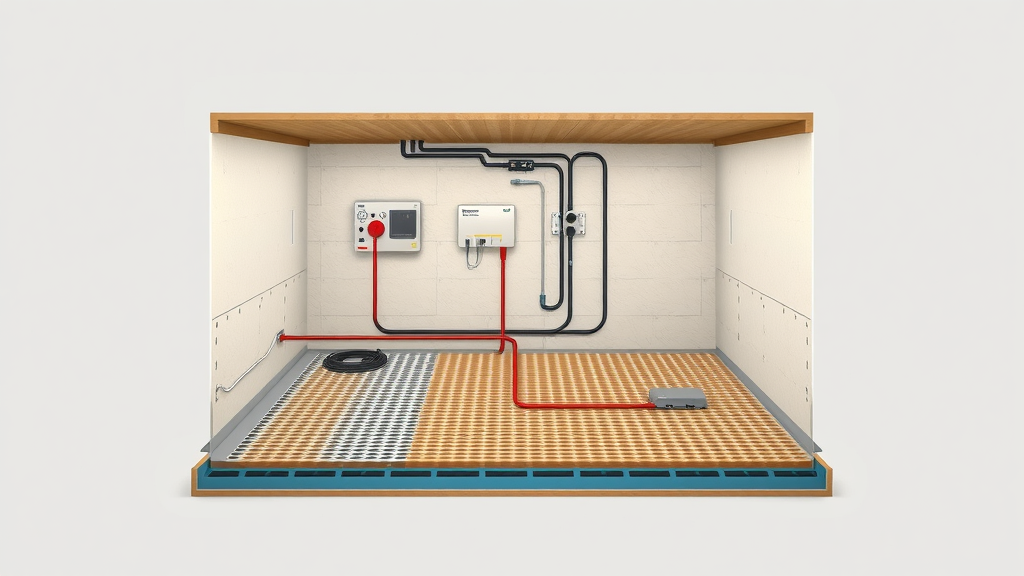Did you know underfloor heating running costs can be up to 25% more efficient than traditional heating systems in modern homes? That’s not just hype—it’s a proven advantage that’s changing the comfort (and cost-effectiveness) of modern living. Homeowners across the UK are reconsidering their options, drawn by the promise of steady warmth and lower bills. But what’s the true cost—and can floor heating genuinely save you money each year? This comprehensive guide dives deep into the facts and figures, helping you make a confident, informed decision about heating your home.
A Startling Look at Underfloor Heating Running Costs
"Did you know underfloor heating running costs can be up to 25% more efficient than traditional heating systems in modern homes?" – Industry Report
When considering a new heating system for your home, understanding underfloor heating running costs is essential. While the initial investment may seem daunting, you could be setting yourself up for long-term savings thanks to superior efficiency and even heat distribution. Unlike outdated radiators that blast heat unevenly, underfloor systems gently warm the entire room from the ground up, reducing heat loss and lowering your heating costs season after season.
Homeowners frequently ask: is it cheaper to run underfloor heating compared to traditional gas boilers or electric heaters? The answer depends on your home’s insulation, energy tariffs, and whether you’re opting for electric underfloor heating or water underfloor systems. In modern, well-insulated properties, running costs can be up to 25% lower than traditional systems—a major benefit given the rising cost per unit of energy across the UK.

What You'll Learn About Underfloor Heating Running Costs
- Factors influencing underfloor heating running costs
- Comparison of floor heating types
- Practical estimates of heating cost and installation cost
- Answers to common questions about underfloor heating cost
- Expert recommendations for optimising running costs
Understanding Floor Heating: What Is Underfloor Heating?
Underfloor heating is a modern heating system that distributes warmth through pipes or electric cables installed under your floors. Instead of relying on radiators that create cold spots and draughts, underfloor systems offer even, gentle heat across your living spaces. This type of floor heating is becoming increasingly popular for new build homes as well as retrofits, thanks to its sleek, space-saving design and its reputation for low running costs.
By gently radiating warmth upwards, these systems minimise heat loss and maximise energy efficiency. For homeowners considering a switch from central heating or electric radiators, the prospect of lower heating costs per year and a more consistent indoor climate is highly appealing. But what does this modern comfort actually involve? The answer depends on the type of underfloor heating system you choose.
Types of Underfloor Heating Systems
- Electric underfloor heating system
- Water underfloor heating systems (hydronic)
- Hybrid heating systems

How Underfloor Heating Running Costs Compare to Other Heating Systems
The big question on every homeowner’s mind: Do underfloor heating running costs outpace—or undercut—traditional heating methods? To answer, it's vital to consider both the type of system—electric underfloor heating or water underfloor heating—and the efficiency metrics. Each delivers warmth in different ways and at distinct cost points, so the best choice will depend on your home’s specific needs, energy tariffs, and expected usage patterns.
A well-installed underfloor heating system often leads to lower running costs per year, especially in well-insulated homes. For example, electric systems shine in smaller rooms or renovations, while water underfloor heating systems (hydronic) offer substantial yearly savings across large, open-plan spaces—particularly when paired with renewable energy sources like a heat pump.
Electric Underfloor Heating vs Water Underfloor Heating Running Costs
Electric underfloor heating systems are simpler to install, especially in smaller spaces or retrofits. Their installation cost is generally lower, but with current electricity prices, their running costs can be higher—especially for large floor areas. However, you can reduce these costs by using energy-efficient controls and only heating rooms as needed. Meanwhile, water underfloor heating systems require more complex installation, usually suited to new builds or major renovations, but benefit from cheaper long-term running costs thanks to lower-cost energy sources (like gas boilers or heat pumps).
When asking about the cost per hour or cost per year, remember that electric underfloor heating systems may cost 13–20p per hour (for a 10 m² room), whereas hydronic systems often work out at a fraction of this—especially when linked to a modern condensing gas boiler or an air-source heat pump. Your actual running cost will vary depending on system design, floor insulation, and energy tariffs.
Underfloor Heating Cost vs Traditional Central Heating
Traditional central heating via radiators works by circulating hot water produced by a gas boiler or heat pump through radiators positioned around the home. Radiators heat rapidly and can be easily zoned, but tend to result in uneven room temperatures and higher rates of heat loss. Underfloor heating, by contrast, creates a steady, comfortable warmth that generally operates at lower water temperatures, boosting energy efficiency.
Despite a higher installation cost for underfloor systems, the lower running cost, improved thermal comfort, and reduced energy use per year convince many homeowners to make the switch. For the modern, well-insulated "new build" home, underfloor heating often results in the lowest heating running cost—and the cosiest environment.
Heating Systems: Key Efficiency Metrics
Choosing your heating system isn’t just about upfront price—but also about long-term efficiency. Key performance measures include system response time, heat loss rates, average cost per hour, annual energy usage, and the efficacy of system controls. Underfloor heating systems, particularly those with smart thermostats or linked to heat pumps, score highly on all these counts, further narrowing their total underfloor heating running costs compared to traditional solutions.
Below is a helpful comparison of core efficiency figures between electric underfloor, water underfloor, and traditional central heating:
| Heating System | Installation Cost (per m²) | Running Cost (per year, avg*) | Efficiency |
|---|---|---|---|
| Electric Underfloor Heating | £60–£85 | £120–£180 (15m² room) | ≈ 100% |
| Water Underfloor Heating | £100–£150 | £70–£100 (15m² room) | ≈ 120–130% (with heat pump) |
| Traditional Central Heating (Radiator) | £40–£60 | £130–£200 | ≈ 90–95% |
*Running costs based on average UK energy tariffs and typical room insulation levels. Actual costs will vary depending on energy provider, insulation, room size, usage, and heating system controls.
Factors Affecting Underfloor Heating Running Costs
The cost-effectiveness of your underfloor heating system doesn’t rest on technology alone. Several key variables dramatically impact both your floor heating running costs and your family’s comfort level. A proper understanding ensures you’re getting the most value from your investment. Let’s break down the big influences:
First, insulation level is critical. Homes with high-performance insulation and draft-proofing lose less heat, meaning your underfloor heating needs to run less frequently. Next, room size & layout matter: larger, open-plan rooms may cost more to heat initially, but underfloor systems distribute warmth so efficiently that the per-square-metre running cost is usually lower. The system type—electric or hydronic—also matters, as does the local energy tariff you’re paying. Lastly, your family’s usage patterns—the time of day and how often you heat each room—will influence your annual spend.
Heating Cost Drivers in Residential Properties
- Insulation level
- Room size & layout
- System type (electric underfloor vs water underfloor)
- Energy tariffs
- Usage patterns

Breaking Down the Cost: Floor Heating Installation Cost and Operation
Let’s get to the nuts and bolts: How much does underfloor heating cost to install and operate? The upfront installation cost varies by system type, underfloor area, and whether you’re fitting in a new build or retrofitting an older property. For a typical home, electric systems may be less disruptive and more affordable to fit, while water underfloor heating is generally more cost-effective to run—particularly if you’re already planning major works.
The real savings emerge over time in the form of lower energy bills. Even taking into account the higher installation costs of water underfloor systems, lower running costs and higher comfort mean many homeowners recoup their investment within just a few years.
Typical Installation Costs for Underfloor Heating
Most UK homeowners can expect to pay between £60–£85 per m² for installing electric underfloor heating and around £100–£150 per m² for a water-based system. This price includes materials, labour, and basic controls, but not extensive floor preparation or subfloor insulation boards. If you’re incorporating underfloor heating into a new build, costs are easier to control—bulk rates on materials and lower labour costs make large installations attractive. In retrofits, installation costs climb due to the need for floor lifting, screed, and rewiring. Remember, insulation boards are a wise upfront investment; they might raise your installation cost by 10%, but deliver year-after-year running cost savings by reducing heat loss.
So, in summary, factor both the cost per m² and any necessary upgrades to achieve the lowest possible running costs in the long term.
How to Calculate Running Costs for Electric and Water Underfloor Heating Systems
To estimate your likely running costs, start with the system’s wattage. For example, most electric underfloor heating systems require 100–200 watts/m². Multiply this by your floor area and typical daily usage. For a 10 m² bathroom using 150 watts/m², running 5 hours per day at 34p per kWh, your cost per day is roughly £2.55, or about £76 per month. Hydronic systems usually cost 20–40% less, especially when powered by an efficient heat pump or modern gas boiler. Also, don’t forget to factor in smart zone controls, which let you heat only the rooms you need, further slashing your heating running cost.
Annual running costs are then usage hours per year x system wattage x energy tariff. Smart controls and insulation make a big difference to your final bills—often, they pay for themselves in under 2 years via the savings they enable.
| System Type | Average Installation Cost per m² | Estimated Annual Running Cost (15m² room) |
|---|---|---|
| Electric Underfloor Heating | £60–£85 | £120–£180 |
| Water Underfloor Heating | £100–£150 | £70–£100 |
| Radiator (Central Heating) | £40–£60 | £130–£200 |
Underfloor Heating Running Costs for Different Scenarios
No two homes are the same—and neither are their underfloor heating running costs. Whether you’re fitting a brand-new home or retrofitting a charming Victorian, application matters. Let’s see how costs differ for key scenarios:
New Build vs Retrofit: Heating Cost Considerations
New build projects make underfloor heating installation a breeze; materials can be bought in bulk, and integration with renewable heat sources (like a heat pump) is easier. This keeps floor heating installation cost per m² down and sets you up for the lowest possible running cost per year. For retrofits, especially in older homes with solid floors or limited insulation, costs rise due to the need to excavate or re-level subfloors. However, the long-term warmth, cosiness, and potential energy savings can still make retro-fit underfloor heating cost-competitive—especially if you plan to update flooring anyway.
Regardless of home age, improved comfort and reduced cold spots are benefits that simply can’t be matched by traditional radiators.
Room Types: Kitchens, Bathrooms, Extensions
- Cost implications for various rooms
- New build vs retrofitting underfloor heating system
- Heating running differences by installation type
Smaller rooms (like bathrooms) typically favour electric underfloor heating for convenience and speed of installation. For larger open spaces (kitchens, living rooms, extensions), water underfloor heating reigns supreme due to its scalability and lower ongoing heating cost per year. Don’t forget: each room’s heat loss depends on its insulation and exposure, so smart design choices during installation make a tangible impact on ongoing running costs.

Saving Money: Is Underfloor Heating Cheaper to Run?
The big question: Is underfloor heating cheaper to run than radiators? For many homeowners, particularly those with well-insulated properties or who install efficient controls, the answer is yes. Lower water temperatures, improved heat distribution, decreased heat loss, and programmable thermostats mean most users enjoy lower annual heating costs—often 10–25% less than comparable radiator-based systems.
Even better, following best practices—from using insulation boards to installing zone controls—and working with the right provider can further shrink your annual energy bill and maximise the lifetime value of your system. Let’s explore the evidence and get practical about saving money.
Comparing Heating Costs: Underfloor vs Radiators
When comparing underfloor heating running costs with radiators, a few big principles stand out. Radiators work by convection, heating the air around them (and frequently resulting in heat loss through ceilings and windows). Underfloor heating delivers warmth via radiant heat, which means you can set your thermostat lower and still feel just as comfortable. This drop in running temperature adds up over the months—leading to notable savings in heating costs per year.
While the installation cost for radiators is often less, factoring in upgrades to insulation and system controls for underfloor heating usually tips the scale in favour of floor systems over a typical “boiler plus radiators” setup—especially in energy-efficient new build homes.
Best Practices to Optimise Underfloor Heating Running Costs
To get the most from your underfloor heating system (and lowest possible running costs):
- Invest in quality insulation boards beneath the system to minimise heat loss and maintain efficiency.
- Install smart thermostats for each zone or room for fine-tuned temperature control and easy scheduling.
- Heat only the rooms you need to avoid unnecessary running costs.
- Utilise off-peak energy tariffs if you have electric systems, slashing your energy bill without compromising comfort.
- Partner with an expert installer to ensure system design aligns with your property’s unique needs—Peak Underfloor Heating Ltd has a proven track record for tailored, cost-effective solutions.
"Underfloor heating systems are designed to deliver comfort and efficiency—adopt energy-saving habits to maximise savings." – Peak Underfloor Heating Ltd

Watch: Expert Insights on Underfloor Heating Running Costs and Savings
An expert walkthrough: Get an inside look at underfloor heating installation, system types, and how running costs stack up against other heating solutions. Clear graphics, real figures, and energy-saving tips throughout.
People Also Ask: Answering Your Queries on Underfloor Heating Running Costs
Does underfloor heating cost a lot to run?
Running costs for underfloor heating depend greatly on the system chosen, insulation, and local energy prices—but in most modern UK homes, it’s surprisingly affordable. Electric systems in a well-insulated 10m² bathroom may cost £120–£150 per year, while water-based hydronic setups for an open-plan kitchen of 20m² can be as low as £90 per year when linked to a heat pump. Compared to traditional central heating, underfloor systems often save 10–25% on annual heating costs, particularly in new builds or after a comprehensive retrofit.
Does underfloor heating use a lot of electricity?
Electric underfloor heating systems are efficient converts of electricity into radiant heat, delivering up to 100% of consumed energy into your room. However, because electricity is more expensive per unit than gas, electric running costs are highest when heating large or poorly insulated spaces. To reduce costs, limit use to essential rooms (like bathrooms) and use a smart thermostat for precise scheduling. For whole-home solutions and lower bills, consider water-based systems instead.
Is it cheaper to run radiators or underfloor heating?
Underfloor heating, when installed with top-tier insulation and modern controls, is usually cheaper to run over the year than radiator systems. Radiators cause more heat loss, require higher flow temperatures, and tend to result in uneven heating. By contrast, underfloor heating systems keep comfort levels high at lower energy requirements. Most UK users experience 10–25% savings annually on heating bills, particularly with water underfloor heating connected to a high-efficiency heat pump or boiler.
Is it cheaper to leave underfloor heating on constantly?
Contrary to some beliefs, it’s usually not economical to leave any heating system on around the clock—unless it's extremely well insulated and managed by a smart thermostat. For best results, set underfloor heating to maintain a baseline temperature during cold months, and ramp up heating only when rooms are occupied. This habit minimises running cost spikes and prolongs system life.
Real Stories: Residential Floor Heating Savings
"After switching to an electric underfloor heating system, we noticed lower running costs throughout winter—our home is cosier, too." – Homeowner Testimonial

FAQs: Underfloor Heating Running Costs and Beyond
How long does underfloor heating take to heat a room?
Most underfloor heating systems take between 30 minutes and two hours to bring a room to temperature, depending on the system type, insulation, and floor coverings used. Water-based systems with well-insulated pipes heat faster and retain warmth longer, while electric systems offer rapid response in smaller rooms.
What is the average cost per square metre for installing underfloor heating?
On average, electric underfloor heating is £60–£85/m², and water underfloor heating costs £100–£150/m². These figures cover materials and labour, but do not always include additional floor prep or insulation upgrades, which are recommended for maximised efficiency.
Do underfloor heating systems increase property value?
Yes! Modern underfloor heating is a sought-after upgrade that adds both comfort and appeal to homes. Many buyers see the inclusion of energy-efficient, low-maintenance floor heating as a sign of a well-improved property, which can increase property value and saleability, especially in new build and family homes.
What are the maintenance costs for floor heating systems?
Underfloor heating systems require minimal annual maintenance. For electric systems, visual inspections and thermostat checks are sufficient. Water underfloor systems benefit from an occasional system flush and inspection of controls—but overall, expect to pay significantly less than for traditional radiator bleeding and servicing.
Key Takeaways: Underfloor Heating Running Costs for Modern Homes
- Underfloor heating running costs can be highly competitive
- Electric underfloor systems suit certain applications; water underfloor for others
- Proper installation and usage habits maximise savings
- Partnering with a reliable provider ensures best results
Conclusion: Ready to Cut Your Heating Costs with Underfloor Heating?
Are you considering a switch to underfloor heating? With lower running costs, superior comfort, and increased property value, the benefits are clear—especially when you partner with a specialist.
Contact Peak Underfloor Heating Ltd to Optimise Your Underfloor Heating Running Costs Today
Ready to experience the comfort, efficiency, and savings of underfloor heating for yourself? Contact Peak Underfloor Heating Ltd for a free, expert assessment and tailored quote. Take the first step to a warmer, more cost-effective home today!
Sources
- Which? – https://www.which.co.uk/reviews/electric-heating/article/underfloor-heating-explained-avTP39c2UgZ7
- The Green Age – https://www.thegreenage.co.uk/guidepage/underfloor-heating-types-costs-and-installation/
- Energy Guide – https://energyguide.org.uk/underfloor-heating-cost/
- Peak Underfloor Heating Ltd – https://peakunderfloorheating.co.uk
When evaluating underfloor heating running costs, it’s essential to consider both installation expenses and ongoing operational costs. Electric underfloor heating systems are generally more straightforward and less costly to install, making them suitable for smaller areas or retrofits. However, they tend to have higher running costs due to electricity prices. In contrast, water-based (hydronic) systems, while more complex and expensive to install, offer lower operational costs, especially when integrated with efficient heat sources like modern boilers or heat pumps. (which.co.uk)
To optimize the efficiency and cost-effectiveness of underfloor heating, proper insulation is crucial. Utilizing high-quality insulation materials beneath the heating system can significantly reduce heat loss, thereby decreasing energy consumption and running costs. Additionally, implementing smart thermostats allows for precise temperature control and scheduling, ensuring the system operates only when necessary, further enhancing energy efficiency. (warmup.com)
For a comprehensive understanding of underfloor heating systems, including their benefits, installation considerations, and cost implications, refer to the article “Considering underfloor heating? How to choose the right system for your project.” This resource provides valuable insights into selecting the appropriate system tailored to your home’s needs. (homebuilding.co.uk)
If you’re serious about optimizing your home’s heating efficiency and comfort, these resources will provide you with the necessary information to make an informed decision.
 Add Row
Add Row  Add
Add 









Write A Comment